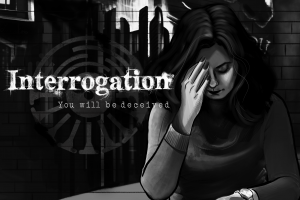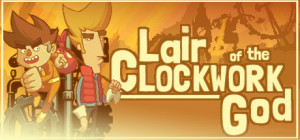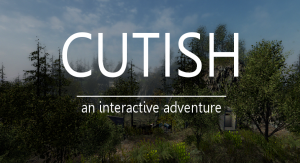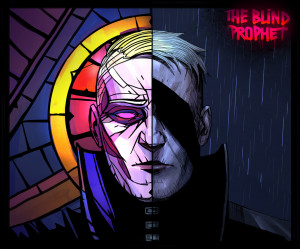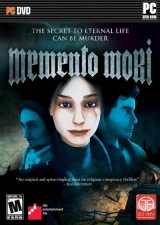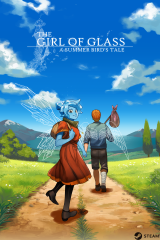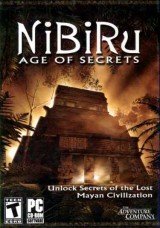Review for Summit of the Wolf
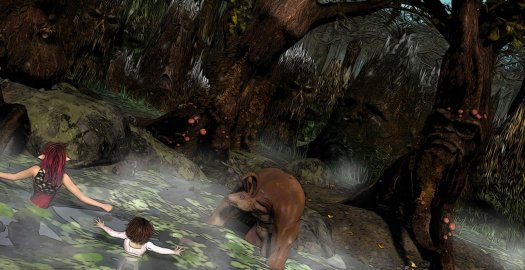
Fantasy has always been a powerful tool for conceiving a better world; after all, change can’t come until someone has imagined what it might be like. A quotation popularly attributed to G.K. Chesterton says that, “Fairy tales are more than true: not because they tell us dragons exist, but because they tell us dragons can be beaten.” This is the philosophy guiding Unimatrix Productions’ Summit of the Wolf, a story about a young girl forced to contend with the unspeakable, who finds strength in a world of her own making. The narrative offers a compelling testament to the power of dreams and the awe-inspiring resilience of those all-too-real survivors of human evil, though its effectiveness is diminished somewhat by a haphazard presentation.
The game opens as young Ophelia’s father reads her a story before bed; despite her apparent disinterest, he insists that it used to be one of her favorites. As he does we see the book’s simple watercolor pages, which tell the tale of a pixie on a quest to restore the sun to the sky. “You’re still my little pixie,” her father says, and then sends Ophelia to bed. Shortly after laying down, she awakens in a lush meadow resembling an image from the storybook to find that she’s been transformed into a pixie herself. There she’s greeted by a woman named Adena, who says that Ophelia was attacked by a savage beast and was whisked away to this “Garden of Eternity” for her protection. Ophelia has no memory of any of this and no idea how to return to her world. The only way for her to do so, she’s told, is to follow her “spirit guide” to the mythical Summit of the Wolf and make a wish there. This will require a journey through many strange and mystical lands, and Ophelia will have to rely on all of her inner strength, wisdom and compassion if she wants to succeed.
Except that isn’t the whole story. No sooner has Ophelia left the garden on her quest than we find ourselves back in the real world. The protagonist, it turns out, is on life support in an intensive care unit, having apparently suffered a tragic accident. The details of that narrative don’t entirely add up, though, and Brianna, the young nurse in charge of her care, is determined to get to the bottom of it. To discover what really happened she’ll have to contend with a coldly clinical supervising physician, an indifferent healthcare system, and the bizarre reticence of Ophelia's parents. Her patient is counting on her, however, and she’s committed to doing what’s necessary.
As the game progresses, we switch back and forth between Ophelia on her quest to reach the Summit, and Brianna in the hospital trying to uncover the truth. Ophelia's segments seem at first to be mostly lighthearted adventures, as she meets fantastical creatures and solves problems to gain their trust. These include the noble Cions, troll-like beings with jackalope heads, and the Spring Eagles, a tribe of moon-fearing gryphons forced to flee underground when a warlock hid the sun. In each location she makes new friends, some of whom—like Roluk, a gentle Cion exile, and Ilea, a young girl who’s been separated from her mother—join her on her journey. It's clear, though, that the world around her is a reflection of her own psyche, and bright and colorful as it is there's a darkness present that she can't escape. Whenever she lays down to sleep, she’s visited by dreams from the night of her “accident,” gradually revealing the truth of what happened; the more we see, the more the parallels in her fantasy world begin to stand out. Eventually you'll begin to encounter darker and more overtly unsettling characters and events, including one sudden late game turn that shocked me with its unexpected brutality.
It’s important to point out that Summit of the Wolf is unflinching in its depiction of incredibly horrific experiences, including sexual abuse and suicide. (The first thing you’ll see on booting up the game is a very frank content warning.) The sequences portraying the events leading to Ophelia's hospitalization are truly harrowing, and while they never seem gratuitous or exploitative, some people will surely have trouble completing them. The game does its best to treat its subject matter respectfully, and it doesn’t use the fantasy elements to diminish or trivialize the real-world evil it depicts. Rather, it uses such imagery to explore the ways victims of trauma can find respite and comfort in the act of imagination, and to show how stories can help those who struggle to envision their own path forward. Ophelia is never judged for being unable to face what she’s endured all at once, nor is her turning to fantasy treated as a way of avoiding or running from it; rather, her dreamscape serves to allow her to process what's happened and to find a way to live. The burden for overcoming her terrible situation isn’t conveyed as resting entirely on Ophelia’s shoulders, either; it recognizes that despite her inner strength she is still, at twelve years old, a largely powerless victim, and that it's necessary for adults like Brianna to intercede on her behalf when they see that something's wrong.
Unfortunately, there's a stark contrast between the game’s heartrendingly effective story and the rest of the production. The problem starts with the glossy pre-rendered graphics, which feel like a poor fit for a story whose fairytale imagery is meant to evoke a child's storybook; the fantasy sequences practically cry out for an art style that matches. What's worse is the graphics themselves, which look out of date at best and unfinished at worst; there’s an uncanny valley quality to the stiff, doll-like character models, while backgrounds tend to contain only as much detail as is necessary to make their subjects apparent. The Cion village, for instance, consists of a single screen featuring only a few visible huts, so that it feels like there's no more to the place than what's needed to solve puzzles. Elsewhere, a castle whose occupants supposedly abandoned it in a hurry is so sparsely adorned that it doesn't look like anyone ever really lived there. Such choices, coupled with the almost total lack of ambient animation, make the game world feel frozen and empty.
Compounding matters is that there's barely any animation to speak of: when characters move at all they appear jerky and halting, resembling a flip book with pages missing, and there are entire sequences in which static models simply float above the ground to simulate motion. It all feels hastily thrown together, especially when compared to the care and effort with which the story and world have so clearly been crafted; they're off-putting enough that the game would improve significantly simply by eliminating its attempts at animation altogether.
The voice acting, too, is mostly underwhelming, though thankfully the player characters are notable exceptions. Ophelia's actress is perfectly cast and does a remarkable job of bringing the character to life, balancing her child-like sense of adventure and wonder with the untimely growing up she's been forced to do; Brianna's voice communicates a mix of steady competence and empathetic warmth, so that it's clear how far she's willing to go for her patients. Other characters' voices, though, frequently fail to match their appearances—Ophelia’s father, for instance, looks to be in his mid-thirties but is voiced as if he were twice that age—or simply miss the tone of the material entirely, as with a warlock who comes across like a cackling cartoon character. There are also some baffling dialogue missteps, such as when Ophelia’s father claims to be “an esteemed professor of psychology at the local elementary school,” and the hospital sequences feature an abundance of misused medical jargon. The synthesized soundtrack is serviceable but mostly unremarkable, largely imitating the harp and other stringed instruments to create a cozy fairy tale vibe.
Gameplay is of the classic first-person point-and-click style, with a context-sensitive cursor and an object line that informs you what action is possible on a hotspot. Movement is done in slideshow fashion, with each room a static screen; exits are signified by the cursor changing into an arrow. The interface is likewise straightforward: clicking your character’s portrait in the lower left corner will show your current goal along with the points you’ve accrued along the way. (Similar to numerous older adventure games, there’s a score that accumulates as you progress; many of the points are awarded for optional actions, so solving all puzzles won't be enough to net you a complete score.) Two icons flank your portrait, one to access the inventory (where you can combine objects as necessary) and another to open Ophelia’s diary, which includes a summary of what’s happened so far, a codex of things she’s learned about the world, and a collection of the writings she finds along the way. (Brianna has her own diary, but she can’t access the rest.) Saving happens automatically as you go, with no manual option; you can’t die except in a single sequence at the end, however, so for the most part it’s only necessary for marking your progress when you quit.
Puzzles are a mix of inventory- and logic-based, and tend not to be terribly challenging; in most cases the solutions are intuitive, though more than once a character will flat out tell you what you need to do before you've had a chance to think about it. Ophelia's segments feature a variety of fantastical tasks, like collecting the ingredients for a transformation spell or laying a trap for a dragon, while Brianna's have you rooting out the truth behind unhelpful characters' double-talk and seeing to patients' needs. At points you’ll encounter timed arcade sequences, featuring a slider that you’ll have to click at just the right moment to perform an action, and there’s one rudimentary combat sequence at the end. There’s also a rather frustrating maze midway through that involves repeatedly manipulating levers to open and close different doors; luckily a map helps to clarify things, but it’s still more tedious than it is engaging. For the most part, though, puzzles are straightforward and easy to figure out; few are outright bad, but neither are they particularly memorable.
Summit of the Wolf is part of Unimatrix’s Storycentric Worlds series, but you won’t need to have played any of the previous adventures to follow the plot. There are numerous references to past entries—Brianna, for instance, was the protagonist of The Filmmaker, and a supporting character from Shady Brook makes an appearance—but the game provides you with all the context you'll need to understand what’s going on. (This was my first Storycentric Worlds game and I had no trouble with it.) Finishing Summit of the Wolf lets you access a series of “bonus scenes” that tie it in more directly with other installments, but the game stresses that these are intended primarily for longtime players to enjoy; not surprisingly, I couldn’t make heads or tails of them.
“Storycentric” is a good way to describe Summit of the Wolf. It presents an interesting, well-developed fantasy world full of deeply resonant symbolism, and its narrative—described in the credits as being “based on the life of an anonymous survivor”—is variously disturbing, heartbreaking, and life-affirming. By the end of its seven-hour playtime, you’ll come to care deeply for the kind, curious child at its center, and you’ll feel every one of her hurts and triumphs. It’s impossible to overlook its shortcomings in other departments, but the story told here of hope and survival in the face of unimaginable horror is likely to stick with players long after they've completed it.








